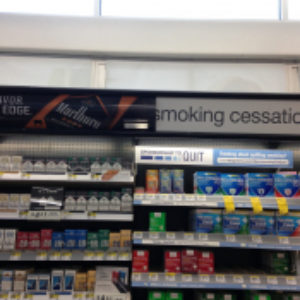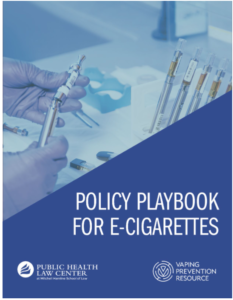Welcome to CounterTobacco.org’s “News and Research Roundup!” Each month we post a summary of the latest research, reports, and news stories on counteracting tobacco product sales and marketing at the point of sale (POS). Keeping up with what’s happening in the POS movement all across the country can help you choose policies and strategies that work best for your community. New research can help provide support for your work and evidence for the importance of the “War in the Store.” Have a story you don’t want us to miss? E-mail it to us!
New Research
Menthol and Other Flavored Tobacco Products
- National Support for a Menthol Cigarette Ban, PublicHealth Reports
- This study aimed to update previous estimates on public support for a menthol ban, including examining differences in support by demographic factors, geographic re
 gion, and smoking status. Based on a nationally representative sample of 2871 adults aged 18-64, findings showed that 56.4% of participants supported a government policy to ban menthol cigarette sales. Support was significantly higher among women than men; among Hispanic/Latino, non-Hispanic African American and non-Hispanic other people than among non-Hispanic White people; and among never and former smokers than among current nonmenthol cigarette smokers. Additionally, 28.5% of current menthol smokers supported a ban. Learn more about federal, state and local menthol policy efforts.
gion, and smoking status. Based on a nationally representative sample of 2871 adults aged 18-64, findings showed that 56.4% of participants supported a government policy to ban menthol cigarette sales. Support was significantly higher among women than men; among Hispanic/Latino, non-Hispanic African American and non-Hispanic other people than among non-Hispanic White people; and among never and former smokers than among current nonmenthol cigarette smokers. Additionally, 28.5% of current menthol smokers supported a ban. Learn more about federal, state and local menthol policy efforts. - News story: Majority of U.S. adults support banning menthol cigarettes, including many menthol smokers
- This study aimed to update previous estimates on public support for a menthol ban, including examining differences in support by demographic factors, geographic re
POS Advertising, Marketing & Promotions
- Public Support for E-Cigarette-related Policies among a Nationally Representative Sample of US Adults, Tobacco Use Insights
- In this study, researchers measured public support for e-cigarette related policies and assessed differences in support by demographics, tobacco use, geographic region, and strength of state-level clean indoor air policies. A nationally representative online panel of U.S. adults was asked about their support for 5 policies: (1) a policy which requires that tobacco products, like e-cigarettes and cigarettes, be kept out of view in stores where adolescents shop; (2) a ban on the sale of fruit, alcohol, or candy flavored e-cigarettes; (3) a policy that would prohibit use of e-cigarettes in all public places; (4) a policy that would prohibit use of e-cigarettes in restaurant; and (5) a policy that would prohibit use of e-cigarettes in bars. A majority of respondents (63.3%) supported a flavor ban, with no differences in support by smoking status. Most respondents supported keeping tobacco products out of view (78.0%) and prohibiting e-cigarette use in indoor public places (82.9%), restaurants (86.5%), and bars (76.1%). This study suggests an increase in public support for e-cigarette policies. Learn more about e-cigs at the point-of-sale and related policy options.
Disparities
- Simulating the density reduction and equity impact of potential tobacco retail control policies, Tobacco Control
- This study uses tobacco retailer locations geocoded from Scotland’s national register to simulate the impacts of potential policies designed to reduce tobacco retailer density. The policies were put into three groups: (1) regulating type of retailer selling tobacco, (2) regulating location of tobacco sales, and (3) area-based density caps. The simulation found policies restricting sales from a specific outlet type caused >80% decrease in tobacco retailer density. However, policies restricting the sale of tobacco in ‘liquor stores’ and ‘pharmacies’ increase socioeconomic inequities in retailer density.
- Tobacco retail environment and smoking: a systematic review of geographic exposure measures and implications for future studies, Nicotine & Tobacco Research
- This systematic review examined papers that measured tobacco outlet density and/or proximity and association with smoking outcomes. The forty eligible articles used varying density and proximity measures.Higher density values were mostly associated with higher smoking prevalence (76.2%), greater tobacco use and smoking initiation (64.3%); and lower cessation outcomes (84.6%). Proximity measures were not associated with any smoking outcome except with cessation (62.5%). Read more on strategies for reducing tobacco retailer density.
International
- Introduction of standardised packaging and availability of illicit cigarettes: a difference-in-difference analysis of European Union survey data 2015–2018 ,Thorax
- The use of standardized (or plain) packaging for tobacco products was first required in Australia in 2012 as a strategy to reduce the appeal of smoking. The tobacco industry argued this would be ineffective, leading instead to increased counterfeit tobacco and evasion of tobacco taxes. In this study, researchers measured the percentage of people reporting being offered illicit cigarettes before and after full implementation of standardized packaging in the UK, Ireland and France and compared this to other European Union countries. In all three countries, the rate of reported illicit trade decreased after implementation of standardized packaging.
Tobacco-Free Pharmacies
- Cigarettes smoked among daily and non-daily smokers following CVS Health’s tobacco-free pharmacy, Tobacco Control
- This article investigates the impact of CVS Health’s decision in September 2014 to stop selling tobacco at its’ pharmacies nationwide. The removal of tobacco products from CVS pharmacies was associated with
 a reduction in the number of cigarettes smoked per day among non-daily smokers, especially in areas where CVS has a large pharmacy market share. The policy was not associated with significant changes in the number of cigarettes smoked by daily smokers. Learn more about tobacco free pharmacies.
a reduction in the number of cigarettes smoked per day among non-daily smokers, especially in areas where CVS has a large pharmacy market share. The policy was not associated with significant changes in the number of cigarettes smoked by daily smokers. Learn more about tobacco free pharmacies.
- This article investigates the impact of CVS Health’s decision in September 2014 to stop selling tobacco at its’ pharmacies nationwide. The removal of tobacco products from CVS pharmacies was associated with
Reports
- Policy Playbook for E-Cigarettes, Vaping Prevention Resource
- University of North Carolina’s Vaping Prevention Resource and Public Health Law Center recently released the Policy
 Playbook for E-cigarettes. The Playbook provides state and local stakeholders with a framework of policies and practices to pursue, guidelines on policy implementation, case studies, and examples.
Playbook for E-cigarettes. The Playbook provides state and local stakeholders with a framework of policies and practices to pursue, guidelines on policy implementation, case studies, and examples.
- University of North Carolina’s Vaping Prevention Resource and Public Health Law Center recently released the Policy
- 2020 State Fact Sheets, truth initiative
- Truth Initiative’s new state fact sheetshighlight up-to-date tobacco information for each state. In addition to smoking rates, the fact sheets also feature tobacco control policies, including tobacco taxes, licensing laws, and youth access laws.
- Global Tobacco Industry Interference Index 2020, Global Center for Good Governance in Tobacco Control (GGTC)
- The Index uses publicly available information to score government efforts to protect policy from tobacco industry influence. The Global Tobacco Industry Interference Index 2020, released by STOP, a global tobacco industry watchdog, outlines how governments were vulnerable to the industry gaining influence, while some acted to prevent it. Patterns emerged showing how (1) Corporate social responsibility initiatives created access to officials and a false perception of tobacco companies as responsible actors; (2) Public officials were offered jobs in the tobacco industry and vice versa, creating potential conflicts of interest; and (3) Tobacco companies exploited a lack of transparency and coordination across government agencies to gain access.
Industry News
- 2One Labs Launches Nontobacco-Derived Nicotine Pouch, CSP Daily News
- Total Nicotine Volume Down for End of October, CSP Daily News
POS Policy in the Media
Menthol and Other Flavored Tobacco Products
- [MO] Kansas City Council Members Consider Banning All Flavored Tobacco Products, KCUR
- [WI] Milwaukee Public Schools Joins National Lawsuit Against E-Cigarette Companies, Milwa
 ukee Courier
ukee Courier - [Durham, NC] Judge denies Juul’s attempt to have N.C. attorney general’s lawsuit dismissed, Winston-Salem Journal
- [MN] Roseville City Council moves forward with ordinance to ban the use of flavored tobacco products, Twin Cities Pioneer Press
- California AG files brief in support of prohibiting retail sales of flavored tobacco products, Fox40
- [PA] Federal Court Enjoins City of Philadelphia Ban on Flavored Tobacco Products, JD Supra
- [MT] City council passes ban on flavored tobacco in Missoula, KQH
- [CO] Loveland City Council to consider first steps toward ban on flavored vapes, Loveland Reporter-Herald
Tobacco Retailer Licenses
- [CA] Board Amends Proposed Ordinance to Curb Youth Tobacco Use, Times of San Diego
- [FL] Buying tobacco products? Martin County just raised the legal age from 18 to 21 years old, TC Palm
Health Warnings
Other
- [Plumas County, CA] New survey finds progress in reducing the availability of harmful tobacco products, but more work needed, Plumas News
- [OR] Oregon’s tobacco tax increase, electronic cigarette tax measure passes, OPB
- Colorado voters approve tax increase, new taxes on tobacco and nicotine with Prop. EE’s passage, The Denver Channel
- [NY] Lawmaker Proposes A Hefty Tobacco Tax Hike, The Post Journal
Find more stories in last month’s News and Research Roundup.
Know of a story that we missed? Email us, and we’ll be sure to include it in next month’s roundup!


